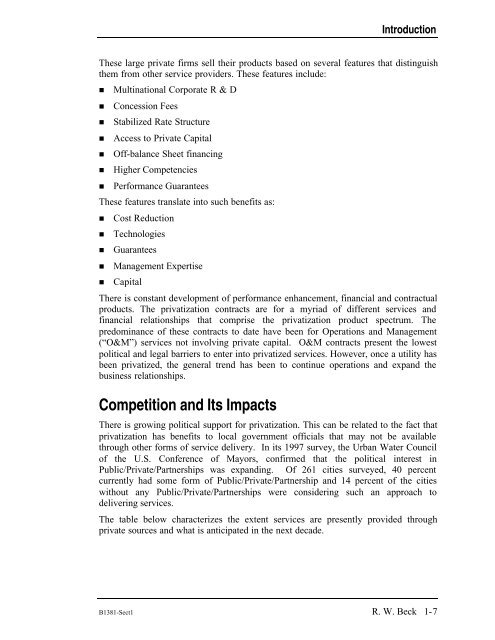Alternative Project Delivery - Texas Water Development Board
Alternative Project Delivery - Texas Water Development Board
Alternative Project Delivery - Texas Water Development Board
You also want an ePaper? Increase the reach of your titles
YUMPU automatically turns print PDFs into web optimized ePapers that Google loves.
Introduction<br />
These large private firms sell their products based on several features that distinguish<br />
them from other service providers. These features include:<br />
• Multinational Corporate R & D<br />
• Concession Fees<br />
• Stabilized Rate Structure<br />
• Access to Private Capital<br />
• Off-balance Sheet financing<br />
• Higher Competencies<br />
• Performance Guarantees<br />
These features translate into such benefits as:<br />
• Cost Reduction<br />
• Technologies<br />
• Guarantees<br />
• Management Expertise<br />
• Capital<br />
There is constant development of performance enhancement, financial and contractual<br />
products. The privatization contracts are for a myriad of different services and<br />
financial relationships that comprise the privatization product spectrum. The<br />
predominance of these contracts to date have been for Operations and Management<br />
(“O&M”) services not involving private capital. O&M contracts present the lowest<br />
political and legal barriers to enter into privatized services. However, once a utility has<br />
been privatized, the general trend has been to continue operations and expand the<br />
business relationships.<br />
Competition and Its Impacts<br />
There is growing political support for privatization. This can be related to the fact that<br />
privatization has benefits to local government officials that may not be available<br />
through other forms of service delivery. In its 1997 survey, the Urban <strong>Water</strong> Council<br />
of the U.S. Conference of Mayors, confirmed that the political interest in<br />
Public/Private/Partnerships was expanding. Of 261 cities surveyed, 40 percent<br />
currently had some form of Public/Private/Partnership and 14 percent of the cities<br />
without any Public/Private/Partnerships were considering such an approach to<br />
delivering services.<br />
The table below characterizes the extent services are presently provided through<br />
private sources and what is anticipated in the next decade.<br />
B1381-Sect1 R. W. Beck 1-7
















